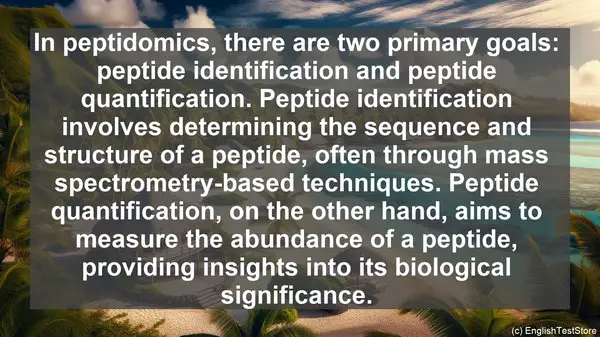Introduction
Welcome to today’s lesson on peptidomics. In this lesson, we’ll be discussing the top 10 commonly confused words in this fascinating field of study.
1. Peptide vs. Protein
One of the most fundamental distinctions in peptidomics is between peptides and proteins. While both are made up of amino acids, peptides are shorter chains, typically consisting of fewer than 50 amino acids, whereas proteins are longer chains. Understanding this difference is crucial when analyzing and characterizing biomolecules.
2. Sequence vs. Structure
In peptidomics, the sequence and structure of a peptide or protein are two essential aspects. The sequence refers to the specific order of amino acids, while the structure refers to how these amino acids fold and interact with each other. Both sequence and structure play vital roles in determining the function and properties of a biomolecule.
3. Mass Spectrometry vs. Chromatography
Mass spectrometry and chromatography are two widely used analytical techniques in peptidomics. Mass spectrometry measures the mass-to-charge ratio of ions, providing information about the molecular weight and composition. On the other hand, chromatography separates and purifies the components of a mixture based on their chemical properties. Both techniques are complementary and often used together for comprehensive analysis.
4. Tandem Mass Spectrometry vs. Single Mass Spectrometry
When it comes to analyzing peptides or proteins, tandem mass spectrometry (MS/MS) offers significant advantages over single mass spectrometry (MS). MS/MS involves a two-step process, where a precursor ion is selected and fragmented to generate product ions. This fragmentation pattern provides valuable structural information, aiding in peptide identification and characterization.

5. De Novo Sequencing vs. Database Search
In peptidomics, there are two primary approaches for peptide sequencing: de novo sequencing and database search. De novo sequencing involves assembling the peptide sequence from the mass spectra alone, without relying on a reference database. On the other hand, database search matches the acquired spectra against a pre-existing database of known sequences. Each approach has its advantages and limitations, and the choice depends on the specific research question.
6. Post-translational Modification vs. Genetic Variation
Peptides and proteins can undergo various modifications after translation, known as post-translational modifications (PTMs). These modifications can include phosphorylation, acetylation, or glycosylation, among others. On the other hand, genetic variation refers to differences in the DNA sequence, which can result in amino acid substitutions. Both PTMs and genetic variations can have significant implications for protein function and disease.
7. Quantitative Proteomics vs. Qualitative Proteomics
Proteomics encompasses both quantitative and qualitative aspects. Quantitative proteomics aims to measure the abundance of proteins in a sample, often comparing different conditions or time points. On the other hand, qualitative proteomics focuses on identifying and characterizing the proteins present in a sample. Both approaches are valuable and provide complementary information.
8. Bottom-up Proteomics vs. Top-down Proteomics
When it comes to analyzing complex protein mixtures, two common strategies are bottom-up proteomics and top-down proteomics. Bottom-up proteomics involves digesting the proteins into peptides and then analyzing these peptides using techniques like mass spectrometry. In contrast, top-down proteomics aims to analyze intact proteins directly. Each approach has its advantages and is suited for different research questions.
9. Peptide Identification vs. Peptide Quantification
In peptidomics, there are two primary goals: peptide identification and peptide quantification. Peptide identification involves determining the sequence and structure of a peptide, often through mass spectrometry-based techniques. Peptide quantification, on the other hand, aims to measure the abundance of a peptide, providing insights into its biological significance.

10. Open Search vs. Targeted Search
In mass spectrometry-based proteomics, there are two main search strategies: open search and targeted search. Open search involves searching the mass spectra against a database, allowing for the discovery of novel peptides or PTMs. Targeted search, on the other hand, focuses on specific peptides or proteins of interest. Each strategy has its applications and can provide valuable insights.
